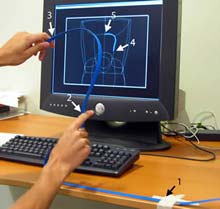Team designs twist on software

Manual manipulation of ShapeTape <br>(Image: Ravin Balakrishnan)
Virtual shapes created on a computer screen by manipulating ShapeTape, a flexible tape-like tool
U of T researchers have created software that will enable users to twist, bend, push and pull shapes in two and three dimensions.”
Our work represents a completely different way of interacting with computers,” says Professor Ravin Balakrishnan of U of T’s Department of Computer Science, who led the research. “It moves away from the ’one-size-fits-all’ keyboard and mouse paradigm to more specialized tools for specialized tasks.”
The team’s software allows users to create virtual shapes on a computer screen by manipulating a flexible tool called ShapeTape in tandem with a foot pedal. ShapeTape, which looks like a long rubber ribbon, has a spring steel core and is embedded with fibre optic sensors. The tape, which is physically held in both hands, can be twisted and bent to change sizes and shapes on screen. It can also locate shapes in three dimensions. “We’re able to do more things in the virtual world,” says Balakrishnan, “while still maintaining a connection to the physical world.”
Balakrishnan says the ShapeTape software could be used to design and refine technical drawings of virtually any product, including computers and cars. The research appears in the Association of Computing Machinery’s Computer-Human Interaction Letters, Volume 5, Issue 1.
Nicolle Wahl is a news services officer with the department of public affairs.
CONTACT:
Professor Ravin Balakrishnan, Department of Computer Science, ph: (416) 978-5359; email: ravin@cs.toronto.edu
U of T Public Affairs, ph: (416) 978-6974; email: nicolle.wahl@utoronto.ca
Media Contact
More Information:
http://www.newsandevents.utoronto.ca/bin4/030415d.aspAll latest news from the category: Information Technology
Here you can find a summary of innovations in the fields of information and data processing and up-to-date developments on IT equipment and hardware.
This area covers topics such as IT services, IT architectures, IT management and telecommunications.
Newest articles

A universal framework for spatial biology
SpatialData is a freely accessible tool to unify and integrate data from different omics technologies accounting for spatial information, which can provide holistic insights into health and disease. Biological processes…

How complex biological processes arise
A $20 million grant from the U.S. National Science Foundation (NSF) will support the establishment and operation of the National Synthesis Center for Emergence in the Molecular and Cellular Sciences (NCEMS) at…

Airborne single-photon lidar system achieves high-resolution 3D imaging
Compact, low-power system opens doors for photon-efficient drone and satellite-based environmental monitoring and mapping. Researchers have developed a compact and lightweight single-photon airborne lidar system that can acquire high-resolution 3D…





















